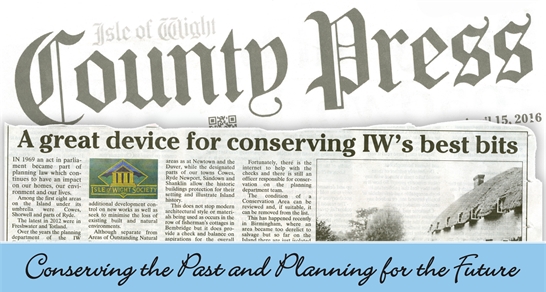December 2016
In 1969 an Act in Parliament became part of Planning Law which continues to have an impact on our homes, our environment and our lives. Among the first eight areas on the Island under its umbrella were Cowes, Shorwell and parts of Ryde. The latest in 2012 were in Freshwater and Totland. Over the years the Planning Department of the Island Council has defined and described the special character of the 36 Conservation Areas on the Island. Not every town or village comes under a Conservation Area but perhaps in the future those larger developments which demonstrate a character and which have historical relevance could be considered for special protection.
The purpose of a Conservation Area is to protect and enhance areas of special architectural and historic interest. They place additional development control on new works as well as seek to minimise the loss of existing built and natural environments.
Although separate from Areas of Outstanding Natural Beauty they can be within it. Although under the Local Authority they can be created through English Heritage. Listed buildings are often found within a Conservation Area and can actually be one, as happens at Appuldurcombe. Ventnor has three areas within the town because the character changes from the sea front to the Downs, and a similar thing has happened at Freshwater but here they are all separated. - Freshwater Bay, Pound Green, Briory Hill and Church Place.
When along the coast they provide very pleasant walking areas as at Newtown and the Duver, while the designated parts of our towns Cowes, Ryde Newport, Sandown and Shanklin allow the historic buildings protection for their setting and illustrate Island history. This does not stop modern archectural style or materials being used as occurs in the row of fisherman's cottages in Bembridge but it does provide a check and balance on aspirations for the overall look of a street and environment.
Knowing the extent of any Conservation Areas is not easy and it is not a necessary part of the searches in conveyancing transactions. There are a number of do's and dont's and responsibilities when making alterations to property. Perhaps the most familiar are checking whether plastic window frames are permissible and whether a tree can be felled or trimmed or whether satellite dishes or solar panels can be installed. Fortunately, there is the internet to help with the checks and there is still an officer responsible for Conservation on the Planning Department team.
The condition of a Conservation Area can be reviewed and if suitable can be removed from the list. This has happened recently in Birmingham, where an area became too derelict to salvage. but so far on the Island there are just isolated buildings, not whole streets, of historic merit suffering from neglect.
In June next year, Civic Voice is promoting walks talks and exhibitions on the Conservation Areas throughout Britain and places like Cadbury's Village for the workers will be a tourist attraction. A trip to Winkle Street, Arreton, or Brading would give any visitor a taste of the variety of Conservation Areas and what is being achieved in enhancing the Island way of life.
[Go Back]

